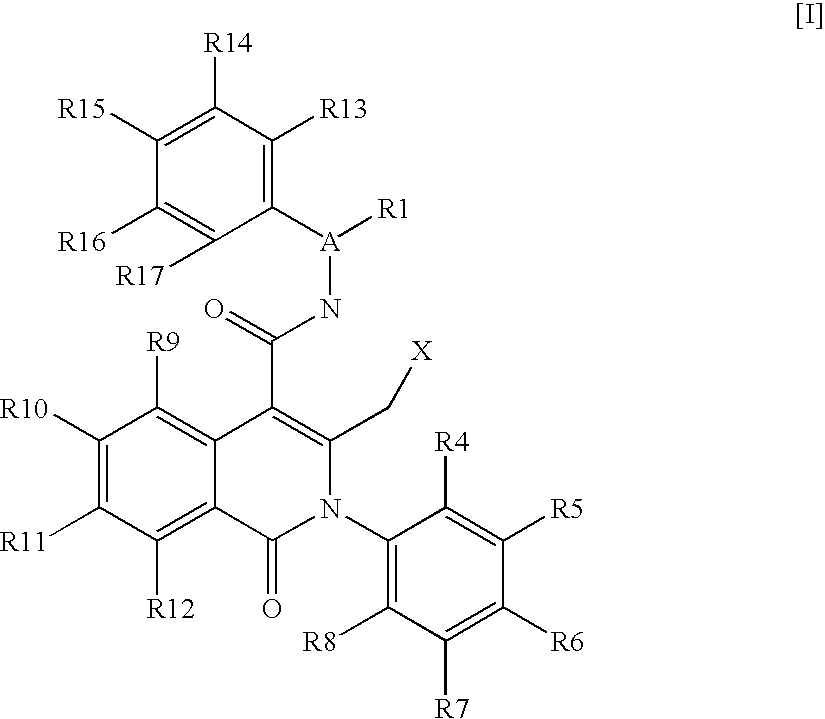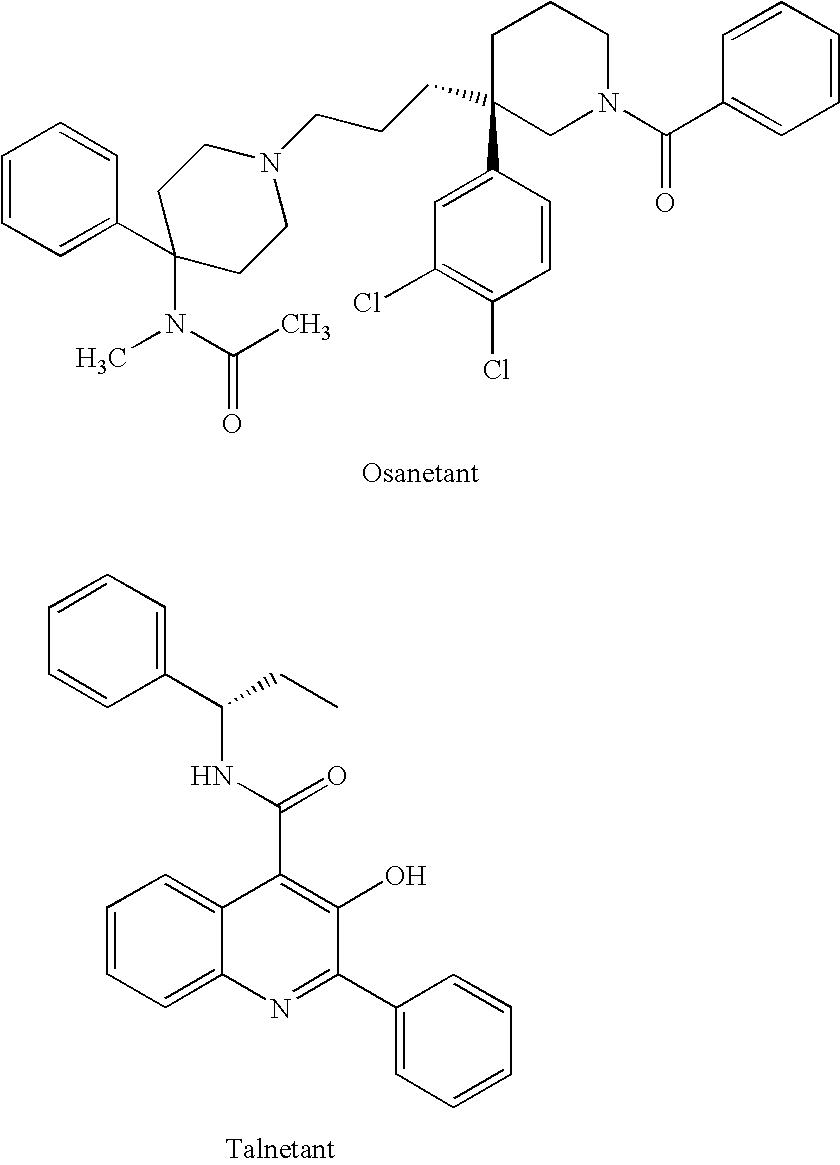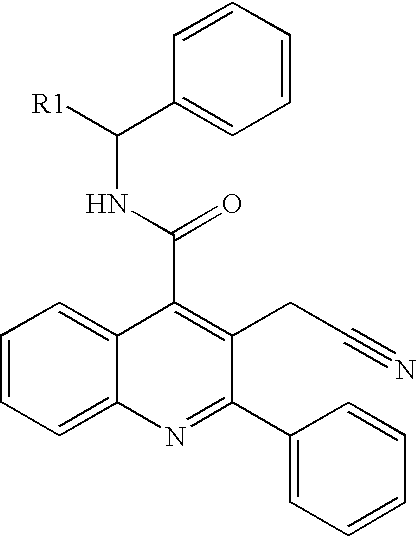Isoquinolinone derivatives as nk3 antagonists
a technology of isoquinolinone and derivatives, applied in the field of compounds useful in therapy, can solve the problems of poor pharmacokinetic and pharmacodynamic properties, hampered by weight gain, and hampered both compounds, so as to delay the progression of the disease, alleviate or relieve symptoms or complications, and reduce the effect of weight gain
- Summary
- Abstract
- Description
- Claims
- Application Information
AI Technical Summary
Benefits of technology
Problems solved by technology
Method used
Image
Examples
example 1
[0670]
1a 3-Methyl-1-oxo-2-phenyl-1,2-dihydro-isoquinoline-4-carboxylic acid ((S)-1-phenyl-propyl)-amide
[0671]A solution of 3-methyl-1-oxo-2-phenyl-1,2-dihydro-isoquinoline-4-carboxylic acid (212 mg, 0.76 mmol) in SOCl2 (1.5 ml) and dimethylformamide (ca. 5 μL) was heated at reflux for 5 min. Volatiles were removed in vacuo to give 228 mg of the corresponding acid chloride as a pale brown solid. A portion of the acid chloride (110 mg, 0.37 mmol) was dissolved in 1,2-dichloroethane (2 ml) and (S)-(−)-1-phenylpropylamine (150 μL, 1.1 mmol) was added. The obtained suspension was shaked for 5 min, diluted with 1,2-dichloroethane (10 ml), washed with 1M aqueous HCl (3×5 ml) and water (5 ml). The organic phase was poured into SiO2 (5 g), eluted with 1,2-dichloroethane (50 ml) and the product was eluted with 1:1 ethyl acetate-heptane to give 140 mg of colourless crystalline solid. Yield 95%. Alternatively, in another run the reaction mixture was partitioned between 2M HCl and heptane (10 ml...
example 2
Preparation of Intermediates
[0711]
3-Bromomethyl-1-oxo-2-phenyl-1,2-dihydro-isoquinoline-4-carboxylic acid ((S)-1-phenyl-propyl)-amide
[0712]To a suspension of CaCO3 (500 mg, 5 mmol) and 3-methyl-1-oxo-2-phenyl-1,2-dihydro-isoquinoline-4-carboxylic acid ((S)-1-phenyl-propyl)-amide (115 mg, 0.29 mmol) in 1,2-dichloroethane (5 ml) bromine (600 mg, 3.75 mmol) was added. The obtained mixture was sonicated at +33° C. for 2 hours, diluted with 1,2-dichloroethane (20 ml) and poured into silica gel column (5 g). The excess of bromine was eluted with 1,2-dichloroethane and the product was eluted with 1:1 ethyl acetate-heptane to give 135 mg of brown solid. It was dissolved in ethyl acetate (0.5 ml) and precipitated with heptane (20 ml) to give 100 mg of yellow-brown solid. Yield 72%. LC-MS (m / z) 475.2 (MH+, 79Br); tR=1.59. 1H NMR (500 MHz, DMSO-d6, a mixture of two interconverting rotamers): 0.95 (br, 3H, CH3), 1.74 and 1.82 (two unres. m, 2×1H, CH2), 4.0 (unres. m, 1H, CH2Br), 4.21 and 4.35 (...
example 3
[0733]
3a 1-Oxo-3-(2-oxo-pyrrolidin-1-ylmethyl)-2-phenyl-1,2-dihydro-isoquinoline-4-carboxylic acid ((S)-1-phenyl-propyl)-amide
[0734]To a solution of 2-pyrrolidinone (0.1 ml) in tetrahydrofurane (2 ml) sodium hydride (20 mg, 60% dispersion in mineral oil) was added. The reaction mixture was stirred at ambient temperature until the gas evolution ceased then 3-bromomethyl-1-oxo-2-phenyl-1,2-dihydro-isoquinoline-4-carboxylic acid ((S)-1-phenyl-propyl)-amide (30 mg) was added. After 30 min acetic acid (0.05 ml) was added and volatiles were removed in vacuo. The product was purified by flash chromatography on SiO2 (5 g, 1,2-dichloroethane then gradient 50% to 100% ethyl acetate in heptane) to give 17 mg of white solid. Yield 56%. LC-MS (m / z) 480.5 (MH+); tR=1.21.
[0735]The following compound was obtained analogously:
3b 8-Chloro-1-oxo-3-(2-oxo-pyrrolidin-1-ylmethyl)-2-phenyl-1,2-dihydro-isoquinoline-4-carboxylic acid ((S)-1-phenyl-propyl)-amide
[0736]LC-MS (m / z) 514.7 (MH+); tR=1.33.
Synthesi...
PUM
| Property | Measurement | Unit |
|---|---|---|
| Composition | aaaaa | aaaaa |
Abstract
Description
Claims
Application Information
 Login to View More
Login to View More - R&D
- Intellectual Property
- Life Sciences
- Materials
- Tech Scout
- Unparalleled Data Quality
- Higher Quality Content
- 60% Fewer Hallucinations
Browse by: Latest US Patents, China's latest patents, Technical Efficacy Thesaurus, Application Domain, Technology Topic, Popular Technical Reports.
© 2025 PatSnap. All rights reserved.Legal|Privacy policy|Modern Slavery Act Transparency Statement|Sitemap|About US| Contact US: help@patsnap.com



